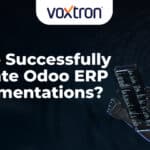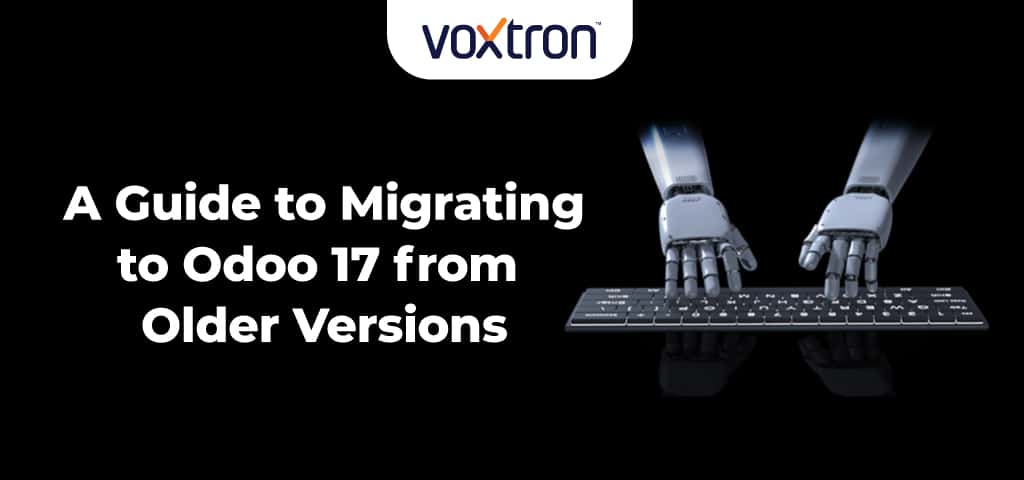
What are the Main Challenges of Implementing Contact Center Chatbots?
February 12, 2024
Everything You Need to Know About Migrating to Odoo 17 from Older Versions
February 27, 2024Practical strategies to Successfully Navigate Odoo ERP Implementations
Implementing any ERP system, including Odoo, necessitates careful planning and expert guidance to ensure a smooth and successful transition. This article provides a comprehensive overview of these challenges, guiding you towards an optimized Odoo rollout.
As an experienced Odoo implementation partner with multiple successful projects under our belt, we have expertly weathered such challenges. Read on to discover the strategies that have enabled us to seamlessly implement Odoo ERP solutions across diverse organizational landscapes.
Best Practices for Successful Odoo ERP Implementations
Developing a proprietary management software is both costly and complex for any business. Furthermore, nearly 50% of proprietary ERP implementations fail because of inadequate customization, unforeseen integration challenges, and a lack of user engagement. This is where solutions like Odoo shine. Nevertheless, Odoo ERP implementations also present challenges.
The two main challenges of any Odoo ERP Implementation are time and budget. When a project fails, it is typically because it took too much time or ended up becoming too expensive.
At Voxtron, we attribute our high success rate for Odoo ERP Implementations to having fine-tuned our methodology to minimize time while maximizing impact.
Let us look at the different factors we focus on to improve outcomes and deliver successful ERP implementations.
Custom development only on a need-basis
Odoo can be extensively customized. However, customization involves extra effort, time, and cost. It also leads to an increase in long-term maintenance and upgrade costs. However, certain customizations are necessary to support the customer’s core business.
Hence, it is necessary to evaluate the business impact of any feature before including it. We educate customers on the long-term implications of any custom features they choose. This helps to make an informed decision that will not be regretted later.
Minimize extra services to reduce the delivery timeline
Focusing on the key functions reduces the risk of failure. Furthermore, it also helps to keep the cost low and competitive.
To maintain the pace of the project and deliver it on time, we focus on the main features initially. Since Odoo supports customization at any stage and is highly scalable, it is feasible to work on mandatory features first. Extra features can be brought in after the go-live phase also. Not only does this reduce the risk of failure, but it also helps to deploy the project faster.
Defining roles with clarity
Traditional ERP vendors define roles like Project Managers, Business Analysts, and Testers, but this often leads to inefficiencies. Odoo, being user-friendly, allows a single person to understand both business and product aspects, a unique advantage over competitors.
For successful and timely ERP implementations, it becomes necessary to evaluate the balance needed – sticking to standards while adapting roles to fit project nuances.
The key lies not just in technical know-how but in orchestrating roles and decision-making for optimal outcomes. It becomes necessary to work closely with the customer to understand the role of different stakeholders and assign suitable roles that will steer the project towards completion faster.
This ensures that the implementation meets deadlines and user expectations.
Efficiently timing the Implementation and managing expectations
A typical Odoo ERP implementation follows this timeline:
| GAP Analysis | 10% |
| Kick-off | 5% |
| Implementation | 80% |
| Go-Live | 5% |
| Second Deployment | Variable |
To complete the project within time, there are three key aspects
Thorough Pre-Implementation Planning:
GAP Analysis: To define project scope, assess feasibility, and build trust with the customer. It involves detailed interviews with key users, process mapping, and proof-of-concept demos.
Solid Project Kick-Off: Clearly communicate expectations, finalize the plan, onboard the customer’s Single Point of Contact (SPoC), and ensure their commitment to learning Odoo.
Planned Implementation:
Phase-based approach: Break down the project into manageable phases, delivering functionalities within each week. This keeps the SPoC engaged and allows for progressive validation.
Configuration & Data Import: Utilize the Project Leader’s expertise for configuration and data migration, while involving the SPoC and key users for training and validation.
Minimal Custom Development: Prioritize standard solutions and only consider custom development for essential business needs. The Project Leader makes final decisions, thereby minimizing delays and budget risks.
User Empowerment & Continuous Improvement
End-User Training: Equip SPoC and key users to handle system setup, training, and user manuals after go-live. This ensures long-term ownership and reduces dependence on consultants.
Go-Live and Beyond: Expect and respond quickly to any initial issues due to data or training gaps. Prioritize rapid go-live and address remaining development in a second phase based on user feedback.
Handling challenges during implementation
Navigating change always presents challenges. Here are some of the roadblocks that commonly arise during Odoo implementations and practical ways to handle them.
User-Resistance:
Early buy-in through user training and demos help to reduce the aversion to change. Support and training enable end-users to get comfortable with the new ERP before they start working with it. This further improves work flows. It also helps to build trust and users are less resistant to the shift once they start seeing the tangible benefits of the new system.
Complexity creep:
Robust and standard solutions help to prevent unnecessary complexity in projects. By keeping things simple, we can present clear options that simplify decision making. This further helps to keep the project streamlined and focused.
Eliminating unrealistic expectations:
Setting achievable goals is critical to aligning an Odoo implementation with user expectations. For this, it is important to discuss potential challenges at the outset. Realistic deadlines and a run-down of potential issues further build trust and ensure a smoother journey. It is equally important to enlist support from key stakeholders to navigate potential bumps.
To Wrap it Up…
The success of Odoo ERP implementation strategies revolves around maintaining a balance between customization, minimizing services, and clearly defining roles. Voxtron prioritizes crucial functions to ensure timely and cost-effective delivery, following a structured implementation timeline. We proactively address user resistance through early engagement, pre-empt complexity with robust solutions, and establish realistic expectations.
For successful Business transformation through Odoo ERP, reach out to Voxtron.




